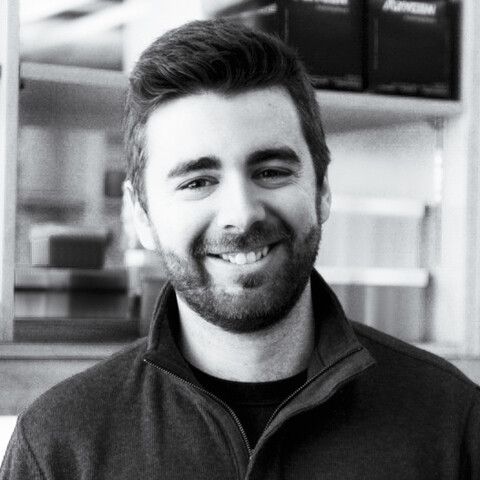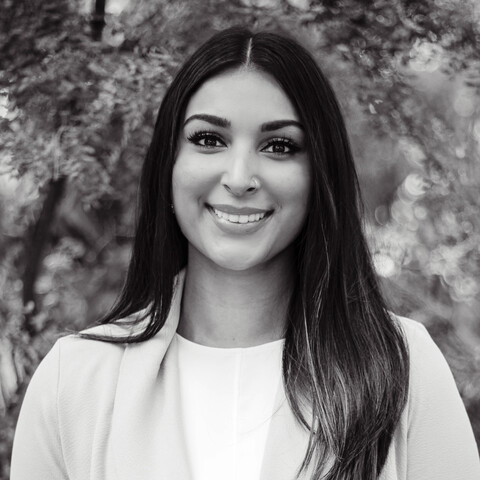Breadcrumbs
Microaggressions and Allyship
Microaggressions and Allyship Campaign: #UofTMedCARES
The goal of the U of T Faculty of Medicine Office of Inclusion and Diversity's Microaggressions and Allyship Campaign (#UofTMedCARES) is to increase the awareness of microaggressions and their impact, begin discussions around microaggressions and allyship, and to encourage individuals to use their privilege(s) to be allies to others. It includes posters, post cards and social media images.
You can help to challenge microaggressions by sharing campaign materials in your own spaces, events, orientations or on social media. To request digital copies of #UofTMedCARES social media content, posters or postcards, email the Office of Inclusion and Diversity at medicine.oid@utoronto.ca.
What are Microaggressions?
Microaggressions are everyday comments or actions that subtly express a stereotype of, or prejudice towards, a marginalized group. Even if the intention was not to cause harm, microaggressions have a huge impact an individual’s wellbeing.
The term "microaggressions" was coined in 1970 by Dr. Chester Pierce, a Black Harvard professor and psychiatrist. The concept emerged from Dr. Pierce's studies of stereotypical representations of Black people in the media.
It is important to understand microaggressions as one way that systems of oppression (such as racism, transphobia, homophobia, or sexism) are enacted at an interpersonal level. They reflect and reinforce harmful dominant imaginaries about which communities are superior/inferior, normal/abnormal, and desirable/undesirable. Cumulatively, microaggressions contribute to larger systemic inequities that create, foster, and enforce marginalization.
When a Microaggression Happens, be an Ally that C.A.R.E.S.
You can help create more inclusive spaces in health care, sciences and education by acting as an ally when a microaggression happens. The acronym C.A.R.E.S. provides some steps you can take as an ally when a microaggression occurs:
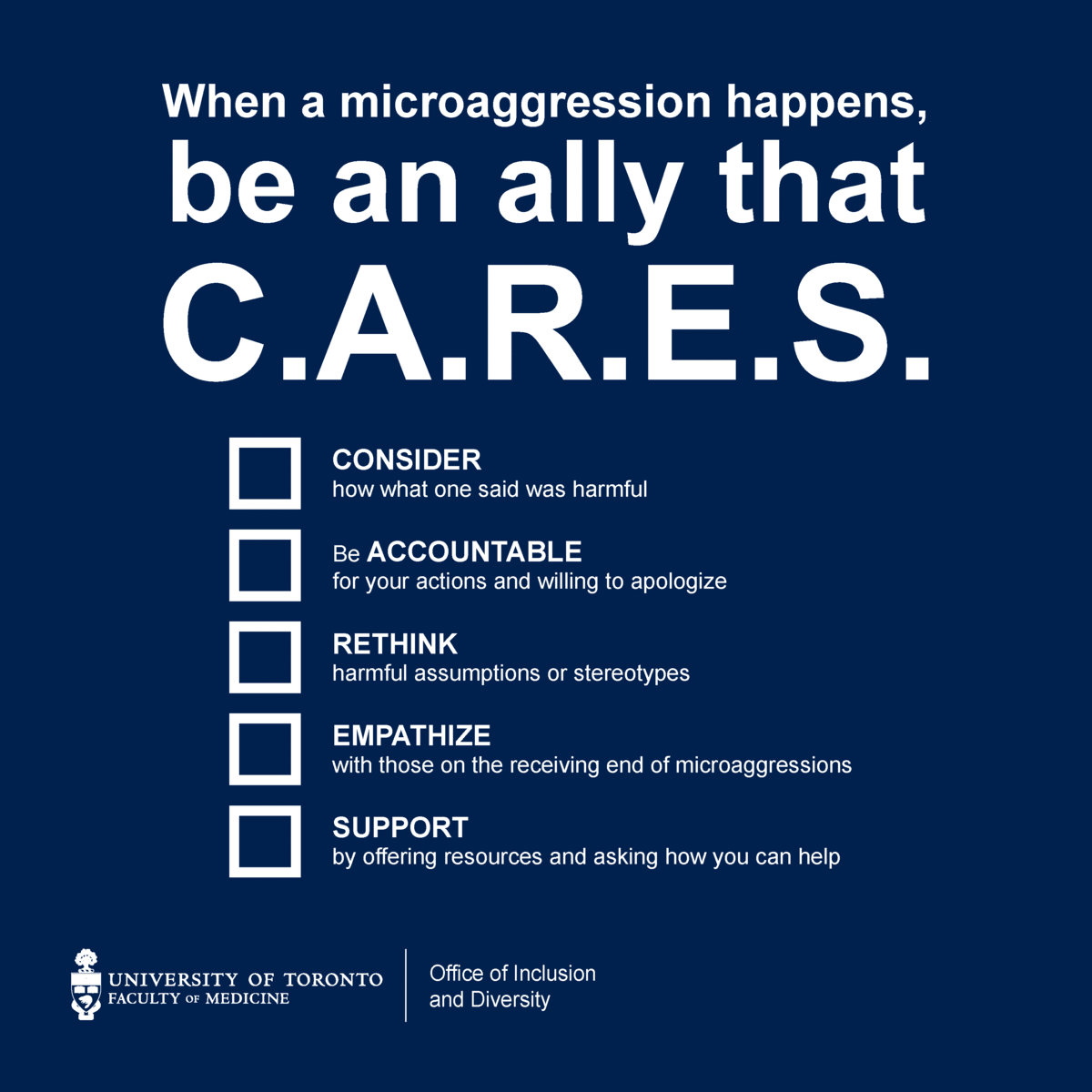 Text version of the C.A.R.E.S. Acronym image: [On a dark blue background with white text] When a microaggression happens, be an ally that C.A.R.E.S.
Text version of the C.A.R.E.S. Acronym image: [On a dark blue background with white text] When a microaggression happens, be an ally that C.A.R.E.S.
- CONSIDER how what one said was harmful
- Be ACCOUNTABLE for your actions and willing to apologize
- RETHINK harmful assumptions or stereotypes
- EMPATHIZE with those on the receiving end of microaggressions
- SUPPORT by offering resources and asking how you can help
[a U of T Faculty of Medicine Office of Inclusion and Diversity logo is at the bottom left hand corner of the image]
Faculty of Medicine learners, staff and faculty can contact the Office of Inclusion and Diversity to request a workshop on microaggressions, allyship and other equity issues. It is also important to engage in allyship at both interpersonal and systemic levels. Learn more about allyship.
This campaign was created in 2020 by Shannon Giannitsopoulou, Program Coordinator, Office of Inclusion and Diversity, and informed by Faculty-wide focus groups of learners, staff and faculty members. The campaign images were designed by Aliyah Mansur (aliyahmansur.com).
Campaign Images: Examples of Microaggressions and Ally Responses
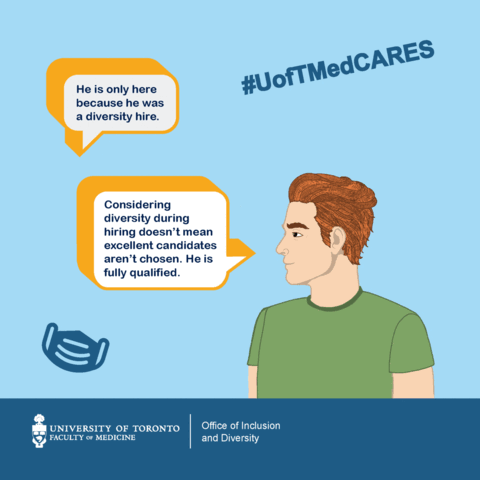
Equitable hiring practises do not mean candidates are chosen just because of their social identity, nor does it mean they are any less qualified. Rethink the assumption that marginalized people owe their accomplishments to diversity initiatives. Making comments that suggest this harmful myth conveys the message that marginalized groups do not really belong in healthcare education, research or professions.
Text version of the Image:
[speech bubble of microaggression]: “He is only here because he was a diversity hire”
[speech bubble of response]: “Considering diversity during hiring doesn’t mean that excellent candidates aren’t chosen. He is fully qualified.”
[a U of T Faculty of Medicine Office of Inclusion and Diversity logo is at the bottom left hand corner of the image]
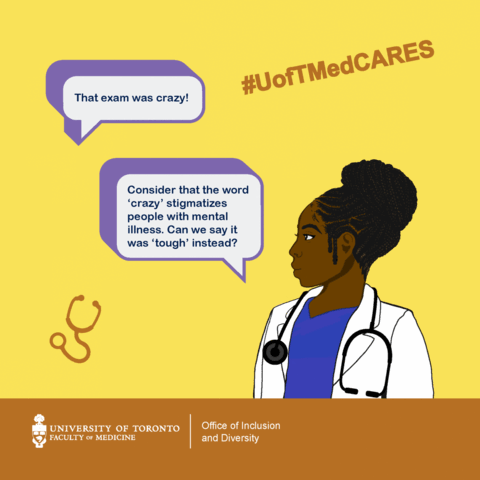
As an ally, if someone uses terms such as “crazy “, “nuts”, or “insane” as slang, ask them to consider how this contributes to the stigmatization of mental illness. You can suggest alternative language to use, such as, “That exam was absurd/awful/difficult/hard/outrageous/ridiculous.”
Text version of the Image:
[speech bubble of microaggression]: “That exam was crazy!”
[speech bubble of response]: “Consider that the word ‘crazy’ stigmatizes people with mental illness. Can we say it was ‘tough’ instead?
[a U of T Faculty of Medicine Office of Inclusion and Diversity logo is at the bottom left h
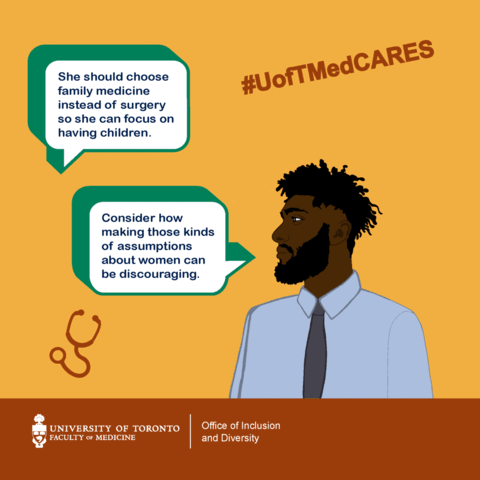
Women in healthcare are often underestimated as a result of biases related to stereotypical gender roles. According to a 2019 study, 73% of female medical students experienced microaggressions, and that only included those who were familiar with the concept. (source: https://bit.ly/2DxOw4o) If someone says a microaggression that perpetuates stereotypical gender roles, ask them to consider the impact of their words.
Text version of the Image:
[speech bubble of microaggression]: “she should choose family medicine instead of surgery so she can focus on having children”
[speech bubble of response]: “consider how making those kinds of assumptions about women can be discouraging”
[a U of T Faculty of Medicine Office of Inclusion and Diversity logo is at the bottom left hand corner of the image]
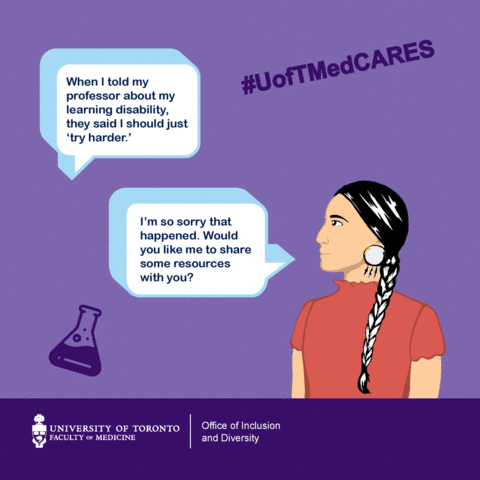
Suggesting that people with disabilities should overcome barriers by "just trying harder" is an ableist microaggression that situates inaccessibility within a person rather than the environment. The social model of disability teaches us that what is disabling is not an individual's medical condition, but rather the ableist attitudes and structures of society. Health care education should be accessible for all. As an educator, implement the concept of universal design by creating learning environments and content that can be accessed, understood and used by all, regardless of age, size, ability or disability. Ensure students are aware of the resources that are available to help them succeed.
Text version of the Image:
[speech bubble of microaggression]: “when I told my professor about my learning disability, they said I should just ‘try harder’”
[speech bubble of response]: “I’m so sorry that happened. Would you like me to share some resources with you?”
[a U of T Faculty of Medicine Office of Inclusion and Diversity logo is at the bottom left hand corner of the image]
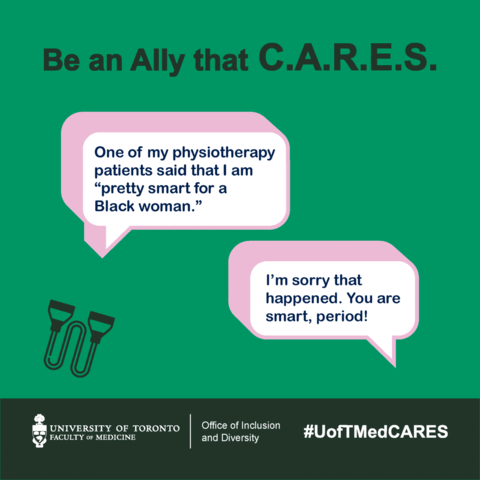
It may be intended as a ‘compliment’ - but expressing surprise that a Black woman is intelligent or in a position of power is a microaggression, and a form of misogynoir (an intersection of anti-Black racism and misogyny). Making comments such as “Wow you are so articulate!” or “You speak English so well!” to racialized people subtly suggests that they are assumed to be lesser, and that they don’t belong in healthcare research or education.
Text version of the Image:
[speech bubble of microaggression]: “One of my physiotherapy patients said that I am ‘pretty smart for a Black woman’’”
[speech bubble of response]: “I’m sorry that happened. You are smart, period!”
[a U of T Faculty of Medicine Office of Inclusion and Diversity logo is at the bottom left hand corner of the image]
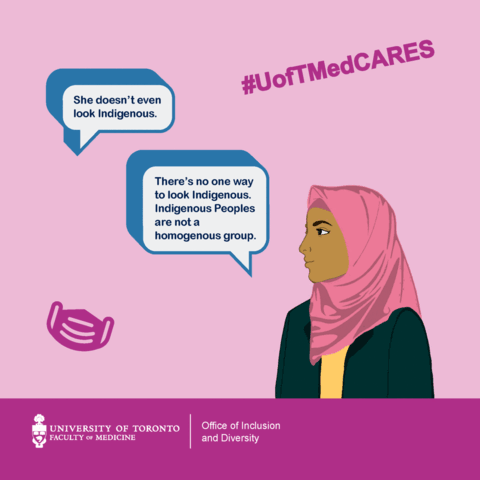
Telling an Indigenous person that they don’t ‘“look Indigenous” is a microaggression. It communicates that they aren’t Indigenous ‘enough’, and perpetuates the idea that Indigenous people are a monolith. In Canada, there are over 600 First Nations bands, who speak over 60 distinct languages as reported by First Nations People (Stats Can).
Text version of the Image:
[speech bubble of microaggression]: “she doesn’t even look Indigenous”
[speech bubble of response]: “There’s no one way to look Indigenous. Indigenous Peoples are not a homogenous group”
[a U of T Faculty of Medicine Office of Inclusion and Diversity logo is at the bottom left hand corner of the image]
Literature on Microaggressions in Health Care Education and Services
- The Impact of Racial Microaggressions on Mental Health: Counseling Implications for Clients of Color
- Racial microaggressions and Asian Americans: An exploratory study on within-group differences and mental health
Unconscious Biases: Racial Microaggressions in American Indian Health Care (note that our Office uses the term "Indigenous" - this was the title used by the source)
An exploratory study on microaggressions in medical school: What are they and why should we care?
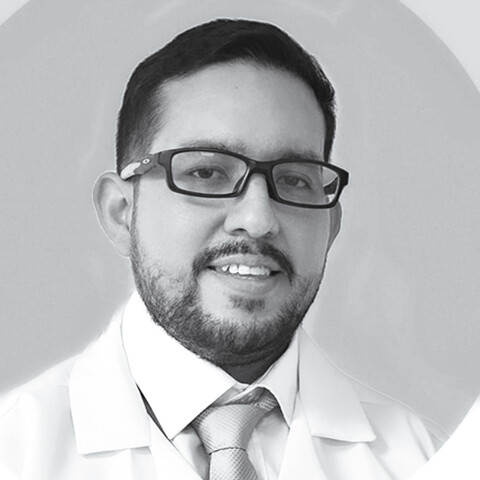
A Little Hurts a Lot: Exploring the Impact of Microaggressions in Pediatric Medical Education
An exploratory study on microaggressions in medical school: What are they and why should we care?

Self-Advocacy, Resources and Supports
If you have experienced or witnessed a microaggression, or any form of discrimination or harassment, you are not alone. U of T Faculty of Medicine learners, staff and faculty can contact our office at medicine.oid@utoronto.ca to access guidance and support, learn about related policies, and/or be connected to other resources, including U of T Equity Offices.
If you are the target of a microaggression, there are many ways you may choose to respond. There is no one right way to react. Here are some options:
In the moment:
- You may not feel safe or comfortable responding in the moment, depending on the situation, power dynnmics and your relationship with the person who enacted the microaggression. You might decide to reach out to the person afterwards to dicuss what happened, or not at all.
- You might decide to self-advocate for yourself by addressing the microaggression in the moment. Here are some articles which provide tips on how to respond when you receive a microaggression:
Afterwards:
- Reach out to the Office of Inclusion and Diversity at medicine.oid@utoronto.ca or U of T central Equity Offices for support and guidance.
- Take care of yourself. You might debrief with a friend or access mental wellness resources at U of T or other community organizations.
- The Faculty of Medicine encourages reporting microaggressions, and forms of discrimination or harassment. You are able to submit a report either anonymously or with your contact information included. The Office of Inclusion and Diversity can help guide you through this process if you do want to report.
Complicating Allyship: Critical Reflections on What It Means to Be an Ally
- Opportunities for White People in the Fight for Racial Justice (Moving from Actor → Ally → Accomplice)
- How to be more than a ‘Performative Ally’ in medicine
- Performative Allyship Is Deadly (Here’s What to Do Instead)
- What is performative allyship? (Instagram post)
- How to Tell the Difference Between Real Solidarity and ‘Ally Theater’
- Accomplices Not Allies: Abolishing the Ally Industrial Complex
Resources on Various Types of Microaggressions (Focus on Each Form of Oppression)
Saneism and Ableism
- 'That's Crazy: Why you might want to rethink that word in your vocabularly: https://www.pennmedicine.org/news/news-blog/2018/september/that-crazy-why-you-might-want-to-rethink-that-word-in-your-vocabulary
- No, you shouldn't call someone crazy: https://www.self.com/story/crazy-mental-health-stigma
Sexism and Misogyny
- A gender divide on microaggressions in medicine: https://www.nytimes.com/2019/10/31/well/live/a-gender-divide-on-microaggressions-in-medicine.html
- Women in medicine more likely to experience microaggressions: https://www.advisory.com/daily-briefing/2019/11/07/microagression
- Reflections from a woman on otherness in medicine: https://blogs.scientificamerican.com/molecules-to-medicine/reflections-from-a-woman-on-e2809cothernesse2809d-in-medicine/
Anti-Indigeneity
- Healthcare racism investigation must go beyond 'bad apples': https://www.princegeorgecitizen.com/news/local-news/healthcare-racism-investigation-must-go-beyond-bad-apples-indigenous-doctor-says-1.24159762
- “Do You Live in a Teepee?” Aboriginal Students’ Experiences With Racial Microaggressions in Canada: https://journals-scholarsportal-info.myaccess.library.utoronto.ca/details/19388926/v07i0002/112_yliataewrmic.xml
Misgynoir (The Intersection of Anti-Black Racism and Sexism)
- Articulate is not a compliment: https://omolaramd.com/blog/2020/3/14/articulate-is-not-a-compliment-ending-the-pervasive-culture-of-racial-microaggressions-in-medicine
- How racial microaggressions impact the mental health of black women of different occupational prestige: https://www.semanticscholar.org/paper/How-Racial-Microaggressions-Impact-the-Mental-of-of-Reid/e43841ffe2eeef1e05dc104f5a8ba566ebaff379tab=abstract&citingPapersSort=is-influential&citingPapersLimit=10&citingPapersOffset=0&year%5B0%5D=&year%5B1%5D=&citedPapersSort=is-influential&citedPapersLimit=10&citedPapersOffset=10
The myth of the "diversity hire": stigmitization faced by minoritized staff and students
- Microaggressions in medical education: https://scopeblog.stanford.edu/2018/05/22/185969/
- To be young, a doctor, and black: overcoming racial barriers in medical training: https://www.npr.org/sections/health-shots/2020/07/01/880373604/to-be-young-a-doctor-and-black-overcoming-racial-barriers-in-medical-training
Racism, Anti-Black Racism
- 'Are you a doctor?' The unchecked racism faced by physicians: https://www.vox.com/first-person/2019/1/2/18144979/doctor-racism-delta-airlines-dr-tamika-cross-fatima-cody-stanford
Fatphobia
- Do medical students realize their anti-obesity bias?: https://oce-ovid-com.myaccess.library.utoronto.ca/article/00001888-201307000-00028/HTML
Anti-Semitism
- Jewish Women Open Up About Their Experienes of Anti-Semitism: https://www.elle.com/uk/life-and-culture/culture/a33470465/three-jewish-women-open-up-about-their-experiences-of-anti-semitism/
Islamophobia
- Subtle and Overt Forms of Islamophobia: Microaggressions toward Muslim Americans: https://quod.lib.umich.edu/j/jmmh/10381607.0006.203/--subtle-and-overt-forms-of-islamophobia-microaggressions?rgn=main;view=fulltext
Anti-2SLGBTQIAP+ (Including homophobia, biphobia, transphobia, intersexphobia, oppression of asexual people, and more)
- Stop Saying “That’s So Gay!”: 6 Types of Microaggressions That Harm LGBTQ People: https://psychologybenefits.org/2014/02/07/anti-lgbt-microaggressions/
A Cis-Person’s Beginner’s Guide to Transphobic Micro-aggressions: https://whatsonqueerbc.com/woq-bc-stories/guide-to-transphobic-micro-aggressions
2SLGBTQIA+ TOOLKIT TO SUPPORT YOUTH EXPERIENCING HOMELESSNESS - What to Say and What Not to Say: https://www.homelessnesslearninghub.ca/learning-materials/2slgbtqia-toolkit/what-say-and-what-not-say
Asexual People’s Experience with Microaggressions: https://academicworks.cuny.edu/cgi/viewcontent.cgi?article=1050&context=jj_etds
Sexual Orientation Microaggressions: “Death by a Thousand Cuts” for Lesbian, Gay, and Bisexual Youth
Classism
“Talking Across Worlds”: Classist Microaggressions and Higher Education: https://www.tandfonline.com/doi/pdf/10.1080/10875549.2015.1094764
Microaggressions and Social Class Identity in Higher Education and Student Affairs: https://onlinelibrary.wiley.com/doi/pdf/10.1002/ss.20262#:~:text=Classist%20Microaggressions,270).
Shame by a thousand looks: The microaggressions of poverty: https://www.salon.com/2019/04/06/shame-by-a-thousand-looks-the-microaggressions-of-poverty/
